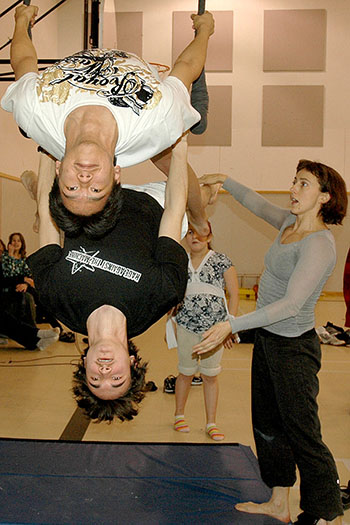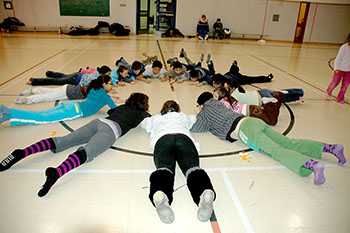Nunavik youth jump head over heels into Cirque project
KRG invites Cirque du Soleil to train youth

A high-flying performance in Ivujivik. (PHOTO BY PHILLIPE CHIASSON)

Stilt walkers in training at a workshop in Quaqtaq. (PHOTO BY PHILIPPE CHIASSON)

Younger people in Kangiqsujuaq were anxious for a chance to participate in circus arts. (PHOTO BY SARAH ROGERS)

“I’ll try not to kick you,” laughs Nathaniel Palliser, on top, as he gets into the mirror position with the help of trainer Rebecca Leonard, right. (PHOTO BY SARAH ROGERS)

Nunavik’s social circus program is modeled after the Cirque du Monde, a Cirque du Soleil project that teaches circus arts to youth at risk in more than 50 countries. The program teaches communication, self-esteem and trust. (PHOTO BY SARAH ROGERS)
KANGIQSUJUAQ – Under the big top of Nunavik’s school gymnasiums, community youth are head over heels about a new circus arts program.
This version is void of wild animals, flaming hoops and bearded ladies. But you’ll see plenty of jugging, clowning and youth hanging from dizzying heights.
A collaboration between the Kativik Regional Government and the renowned Cirque du Soleil, this social circus hopes to grow roots in each of the region’s communities over the next five years.
The social circus refers to a growing movement toward the use of circus arts for social good. It is considered an arts-based education, often geared towards marginalized youth.
Circus trainers started doing workshops in Nunavik communities last September; students in Kangiqsujuaq received their first visit from Cirque du Soleil trainers last week.
“My hands hurt,” admits Gregory Pilurtuut, with a hint of pride and frustration. He’s seated on a mat after attempting the “bird’s next” trapeze position, now offering his encouragement to fellow students.
Secondary students and young adults have been introduced to acrobatics, aerials and clowning (yes – clowning is an art.)
“It’s fun but when you try it for the first time, it’s pretty complicated,” Pilurtuut said of his trapeze experience. “I think the more we try it, the easier it gets.”
“And they’ll be more motivated to do it,” he said, gesturing to onlookers.
Pilurtuut is right. During the Cirque’s brief visit, hesitant youth have been coaxed off the sidelines and into positions that challenge their physical strength, their self-esteem and how much trust those around them.
That is essentially the aim of the social circus, said Rebecca Leonard, a Cirque du Soleil trainer working on the Nunavik project.
“It’s watching their fears unfolding,” she said, “whether it’s on the trapeze or in the real world.”
“This program is not top-down – it’s gotta come from the participants,” she said. “And it can go in so many directions, there’s something for everyone.”
The direction this particular circus arts program eventually goes is in the hands of Nunavik youth. Although the program is based on Cirque du Soleil’s Cirque du Monde project for youth at risk, the regional program has yet to earn its name yet – that will come, organizers say.
“We want to make sure it represents not only the program itself, but also the region,” said Philippe Chiasson, a KRG recreation and development advisor who deals with project logistics.
With a five-year lifespan, this social circus’ goal is to pick out the local leaders in each community — those who have showed passion and skill in circus arts.
During future visits, the plan is to train these youth to maintain the program locally and share it with younger enthusiasts.
“I’d say that once we’ve done the first visit, there’s a lot of anticipation,” Chiasson said. “For the second visit, we really like what we see.”
“There’s a lot of kids that have a lot of potential.”
The interest so far has been high, Chiasson said, considering that many of the targeted youth — 15 years and over — have never seen a Cirque du Soleil show in person.
It’s not always easy to spot leaders after a week-long workshop, said circus trainer Simon Rioux, but some strong interest has emerged.
Someone in Kuujjuaraapik crafted their own stilts during the circus’ last visit there; another trainee in Salluit is already a talented juggler and unicyclist. Rioux believes that Inuit youth have the talent to make this project their own.
“It’s a great project for Nunavik,” Rioux said. “There were already kids doing back flips at home before we got here.
“We can always adapt new things into our performance.”
That is where Inuit culture can influence this performance art; Rioux points to the Arctic Games which he calls a great showcase of acrobatic skill.
At the end of a brief but intense visit to Kangiqsujuaq, there are a few sore arms and legs while participants revel in the new tricks they’ve learned.
“In the end, the community notices the improvements that they’ve have made,” Rioux said. “And that’s gratifying.”





(0) Comments